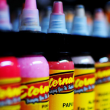The SNAT claims that “Tintin himself had found a legal error in the decree of January 6, 2013”.
As it turns out, there was no error in that decree that just came into effect on January 2014.
A legal error would have indeed allowed it to be repealed. Instead, the legal consultant hired by Tatouage & Partage unveiled a mistake in the interpretation of the original decree; a mistake made by a government control agency that wasn't associated to the French Ministry of Health.
Our consultant reached out to the ITC, asking for the control agency's findings after it had conducted an inspection at the Mondial De Tatouage in Paris.
No minutes had been written according to the ITC. The consultant then told the ITC that there seemed to be no legal base for an inspection and that in his opinion, after studying the decree, all forbidden products were actually allowed.
The conversation took place on December 10, 2013, the day before “Tintin himself found a legal error”, and the day before a letter was sent to the ministry on December 11. (See the ministry's response dated December 23).
So why did Stéphane Chaudesaigues, President of Tatouage & Partage and also a member of the SNAT, would hire a legal consultant to study the file on colored tattooing inks? That couldn't be for personal gain as it's been said before, because over 90 percent of his work is done in black and white.
Could an oversized ego be the answer ? It's true that Stéphane likes to be seen, but it's often to highlight his peers and his colleagues at events such as the Chaudesaigues Award or the Festival du Tatouage de Chaudes Aigues in the Cantal region.
Maybe he stepped up to the plate because a number of his concerned colleagues asked him to get involved.
The Findings Are Damning For The SNAT.
The Ministry of Health allowed a 6-month stay of application of the decree for one reason: to enable the SNAT to produce scientific proof that some of the colored tattooing inks named in the decree as forbidden were in fact innocuous. During the extension, the SNAT made no efforts to communicate with the French Ministry of Health.
The SNAT didn't bother looking for alternate ink suppliers and didn't reach out to organizations in other European countries where the decree was already in effect. Contrary to what the SNAT wrote in a letter addressed to the French Surgeon General, other European countries such as Germany are under a similar law since 2006. Such inaccurate statements do little more than discredit the organization that authored them.
Stéphane Chaudesaigues asked the DOT, the union of German tattoo artists, how they dealt with the law. Surprised with the question, the DOT answered that they simply turned to a supplier that distributed approved inks; in this case it was Bullets. Why did the SNAT stay idle for 6 months? What was the motivation for this stagnation?
Ignorance, Incompetence, Or Something Else?
This is what motivated Stéphane Chaudesaigues to hire a legal consultant to represent the Tatouage & Partage association.
He had been standing behind the SNAT all along, and even paid the printing costs for a petition started with Jim Appay to defend colored inks.
The petition was the work of a young enthusiast who wanted to show the government that the tattooing community was united behind the SNAT during a audience with the Assemblée Nationale on November 27, 2013. The SNAT reacted by saying that the petition and the meeting at the Assemblée Nationale should not be brought up because it would imply that it was the petition alone that made way for an audience…
So what? Would that be so bad? What's wrong with showing that mobilizing people around a common cause can actually yield results?
Who's Trying To Get All The Credits Now?
Armed with specific data and a clear plan, Tatouage & Partage was able to meet with the Ministry of Health on December 12, 2013. The meeting was facilitated by Senator Pierre Jarlier and his team.
A well documented proposal was all it took to meet with the government officials.
The Ministry was quick to respond to the enquiry where we underlined the shortcomings of a bad interpretation of the decree, and was kind enough to reach out to the SNAT with an update.
We all know that the SNAT should have been the one talking to the government in the first place, asking questions and presenting a proposal.
But that would have required an involvement, a competent approach and enough common sense to get help from knowledgable people.
Don't Blame Your Own Negligence And Incompetence On Others.
It's time that the SNAT stops grandstanding on the legal status of tattooists. You don't just call yourself an artist like that.
Only a few, as a result of their body of work, are elevated to that rank. But before that actually happens, one must master one's craft, and this level can only be attained through rigorous apprenticeship done under the expert supervision of a master.
The best goldsmiths, jewelers, fashion designers, designers and decorators don't even have the legal status of an artist. They are craftsmen and yet, they are very creative and some of them are even called master craftsmen.
The SNAT wants free schooling that's accessible to all at the public Beaux Art school. But this school only opens its doors to high-school graduates who pass an admission exam and students who attended expensive private prep schools. A simple internet search will also show a number of schools of tattooing that are far from free, and range from 1500€ to 6000€. Pandering!
The SNAT writes that the CAP program would be an easy shortcut to becoming a tattooist.
But keep in mind that obtaining the CAP involves a two-year paid internship in a tattoo shop, alternating with general education dispensed by a free trade school, as Stéphane Chaudesaigues outlines it.
Keep in mind that Tatouage & Partage has not specifically defined any kind of diploma at this point, but has been expressing the urgent need for a constructive debate to take place.
Government agencies in Europe and France have already been working on ways to regulate our profession. This controversy over the CAP certification is nothing more than a decoy from the SNAT, in an effort to distract its members who might otherwise be asking themselves a few questions about their recent actions.
So where are we today? Anyone can open a tattoo studio with the local business bureau after attending a 3-day seminar on hygiene. In other words, anyone can open a tattoo shop.
Lies And Pandering!
The SNAT quotes article 98 A from annex III of the tax code to claim the legal status of artist. But the SNAT seems to forget a small detail. The tattooist never owns the art since it's part of the buyer's body, and no part of the human body can be marketed or sold.
Article 16-1 Loi n°94-653 du 29 juillet 1994 - art. 3 JORF 30 juillet 1994
A person's body must be respected.
The human body is sacred.
The human body, its elements and its products can be part of a trade.
A tattooist simply can not claim ownership on a tattoo that he has inked and can't be seen as more than a service provider in this case.
Furthermore, the client is the one who decides to get a tattoo, what kind of tattoo, its size and placement.
As a result, the tattooist's creativity is limited by his client's will. On the other hand, the tattooist can claim to be an artist as it relates to the original piece of art that he created for the tattoo, whether it's a painting, a drawing or engraving done in the conditions outlined in article 98A-. And the tattooist can join the Maison des Artistes, if he fills all the criteria.
French Law Would Have To Be Changed Significantly For A Tattooist To Ever Get The Legal Status Of Artist.
Pandering ? Utopia ? Incompetence ? Maybe all three at the same time !
A bird in the hand is better than two in the bush. If we can't get artists status, at least we can ask to be seen as craftsmen.
The SNAT has nothing but contempt for the title or craftsman, but you should visit the web page for The Masters Of Art http://www.maitresdart.com/ and see for yourself. After that, you may change your mind about being a craftsman!

